Classic New York Cheesecake
This post may contain affiliate links. Read my full disclosure policy.
Think making cheesecake is difficult? Think again! This foolproof recipe delivers a cheesecake that’s dense, rich, and creamy—rivaling those from New York’s most beloved delis—and it’s simple enough for beginners to master.
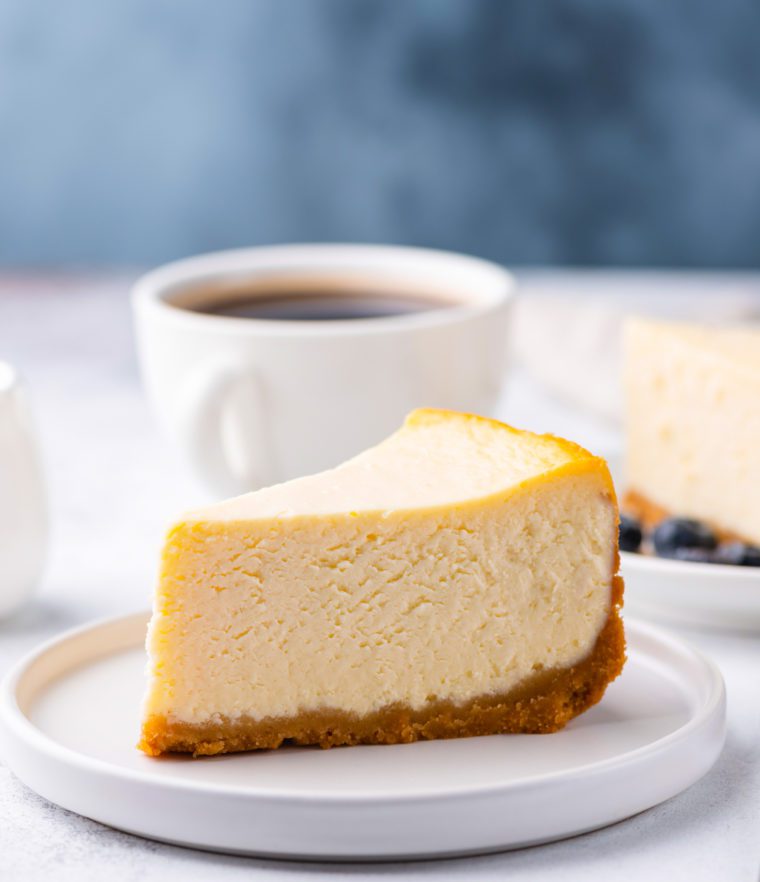
Cheesecake has always been my husband Michael’s favorite dessert. I remember when I first met my future mother-in-law over 20 years ago, she told me the key to her son’s heart was through his stomach—and he could be persuaded to do just about anything for a slice of NY cheesecake. Fortunately, I had just graduated from culinary school, so I had a little advantage in both winning his heart and perfecting my cheesecake recipe!
I know making cheesecake can seem a little intimidating. It’s a custard dessert that needs careful baking in a water bath to prevent cracking and to get that perfect, creamy consistency. But don’t let that scare you off. With a few pointers and a tried-and-true recipe, even beginners can whip up a dense, rich, and crack-free cheesecake. This is the kind of tradition-worthy dessert that rivals the best New York delicatessens—and who knows, it might even help you win someone over!
“I made this for my family at Christmas time and everyone LOVED it! I had never made a cheesecake before. The instructions were simple and easy for beginners. I am now tasked with making this for birthdays and holidays!”
What You’ll Need To Make New York Cheesecake
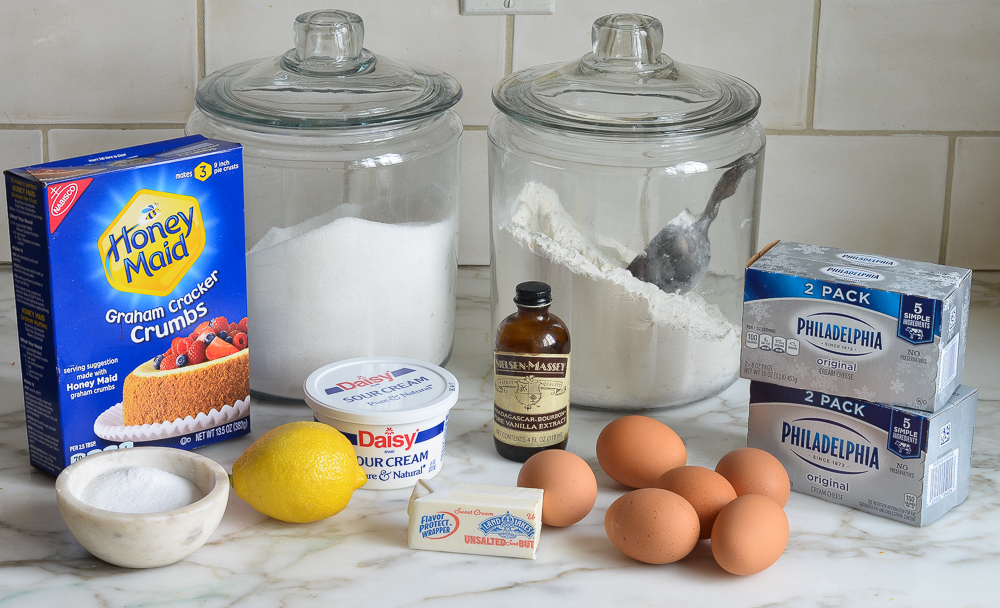
- Graham cracker crumbs: Forms the base of the crust, providing a sweet, crumbly texture.
- Butter: Binds the graham cracker crumbs together and adds richness to the crust.
- Sugar: Sweetens both the crust and the filling, balancing the tang of the cream cheese and lemon.
- Salt: Enhances the flavors of both the crust and filling.
- Cream cheese: The key ingredient of the filling, it provides the rich, creamy texture and tangy flavor. I recommend using a good brand, like Philadelphia.
- All-purpose flour: While it may seem unusual in a cheesecake, the flour is the secret to success. A little starch helps prevent cracking and makes the filling lighter and fluffier.
- Vanilla extract: Adds warmth and enhances the sweetness of the filling.
- Lemon zest and juice: Adds a subtle brightness and tang that cuts through the richness of the cream cheese.
- Eggs: Give the cheesecake its structure and help it set while maintaining a smooth texture.
- Sour cream: Adds extra creaminess and a slight tang, balancing the sweetness.
- Jump to the printable recipe for precise measurements
Key Equipment
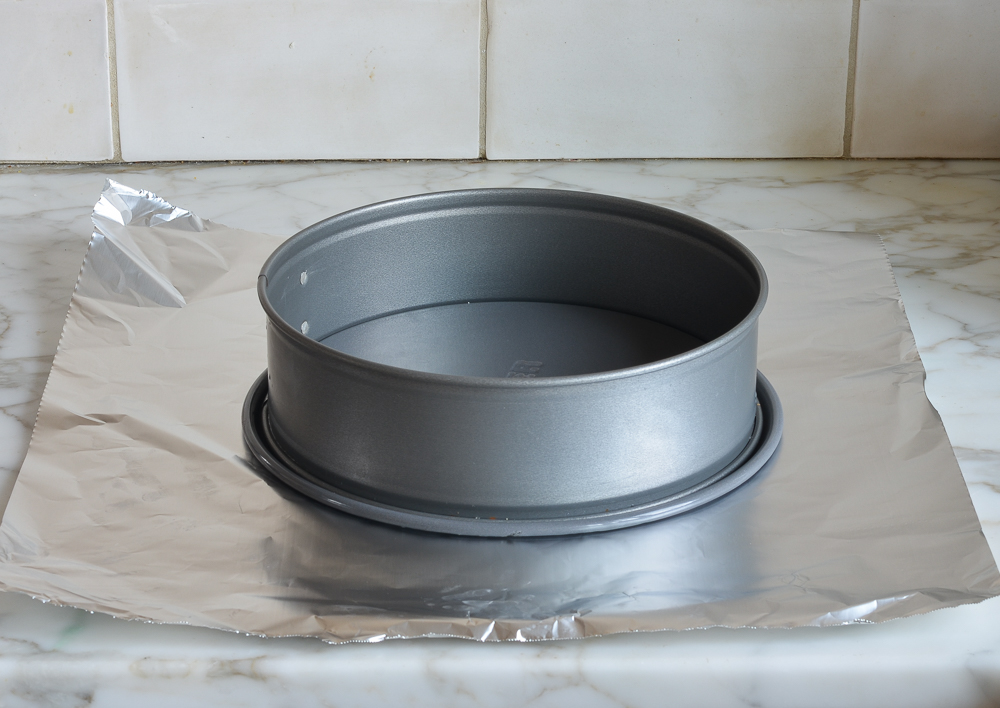
You’ll need a 9 or 10-inch springform pan and 18-inch heavy-duty aluminum foil. The springform pan features sides that can be removed from the base, so you can release the cake easily without having to flip the whole pan over (this would be a disaster with cheesecake). Springform pans, however, are notorious for leaking. Since the cheesecake bakes in a water bath, the foil prevents the water from seeping in during baking. If you’d like to try another technique that doesn’t require wrapping the pan in foil, you can place your springform pan inside a larger cake pan (see how it’s done here) or purchase a silicone wrap for your pan.
You will also need an electric mixer for whipping up the batter and a large roasting pan for the water bath.
Step-by-Step Instructions
Step 1: Preheat the Oven and Prep the Pan
Preheat the oven to 375°F.
Wrap the springform pan with one large piece of heavy-duty aluminum foil, covering the underside of the pan and extending all the way to the top. Repeat with another sheet of foil for insurance. Spray the inside of the pan with nonstick cooking spray.
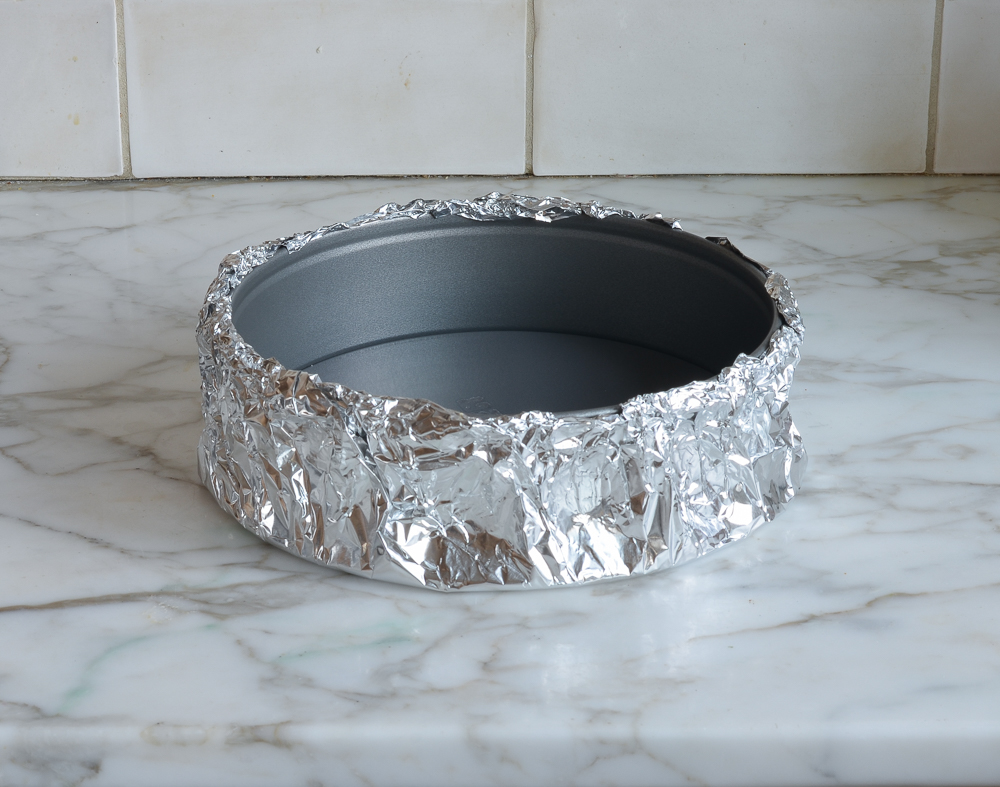
Step 2: Make the Graham Cracker Crust
In a medium bowl, combine the graham cracker crumbs, melted butter, sugar, and salt.
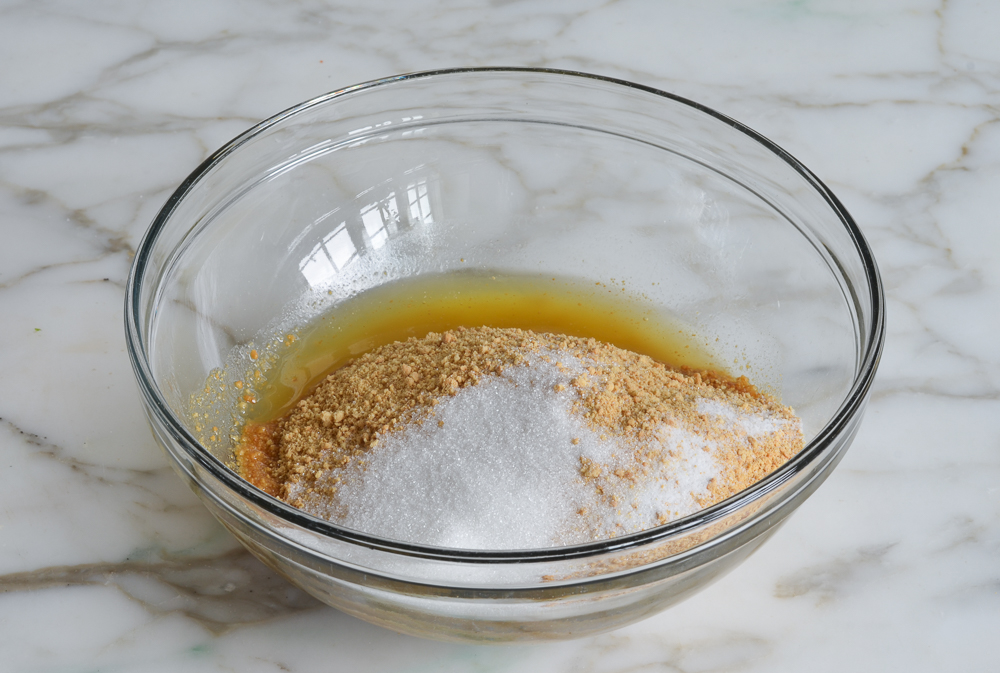
Stir until well combined.
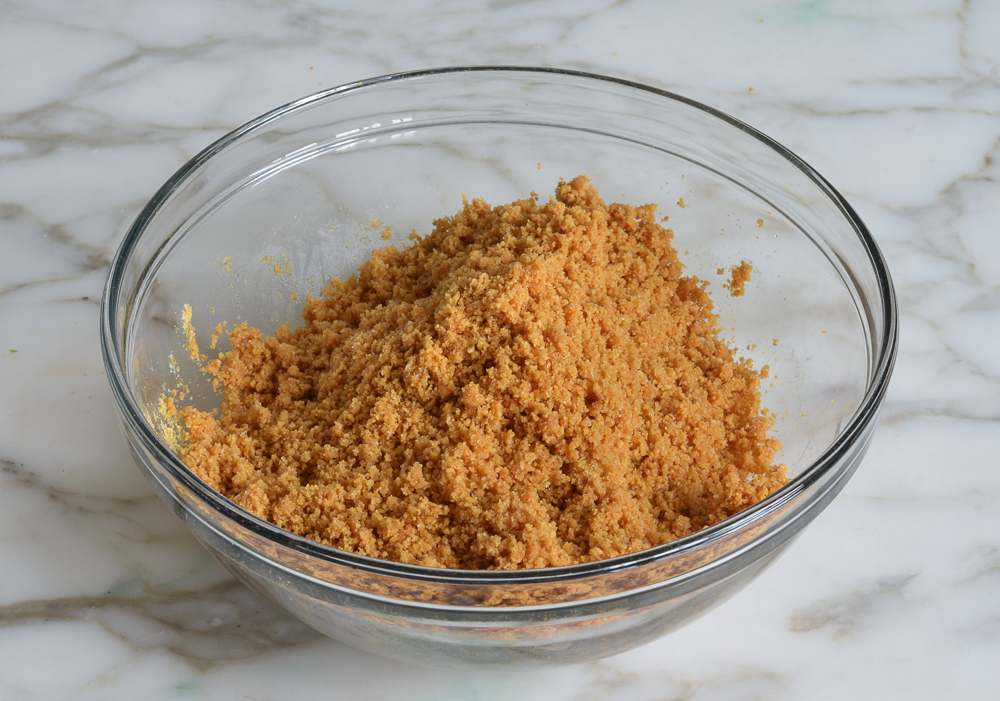
Press the crumbs into an even layer on the bottom of the prepared pan. Bake the crust for 10 minutes, until set. Remove the pan from the oven and set aside. Reduce the oven temperature to 325°F.
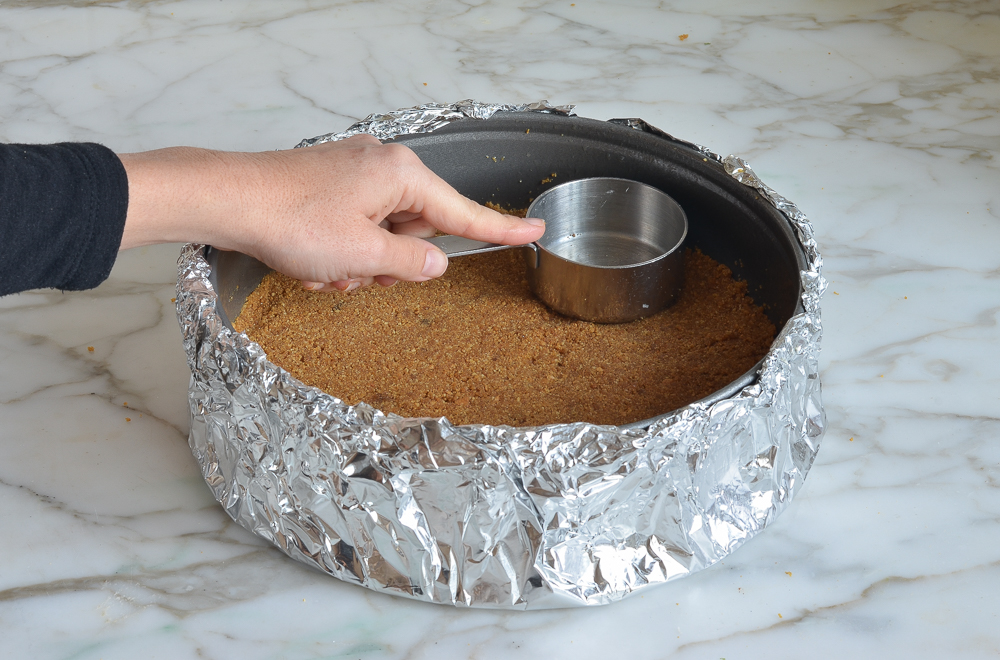
Step 3: Make the Cheesecake Batter
In the bowl of an electric mixer fitted with the paddle attachment or beaters, combine the cream cheese, sugar, and flour.
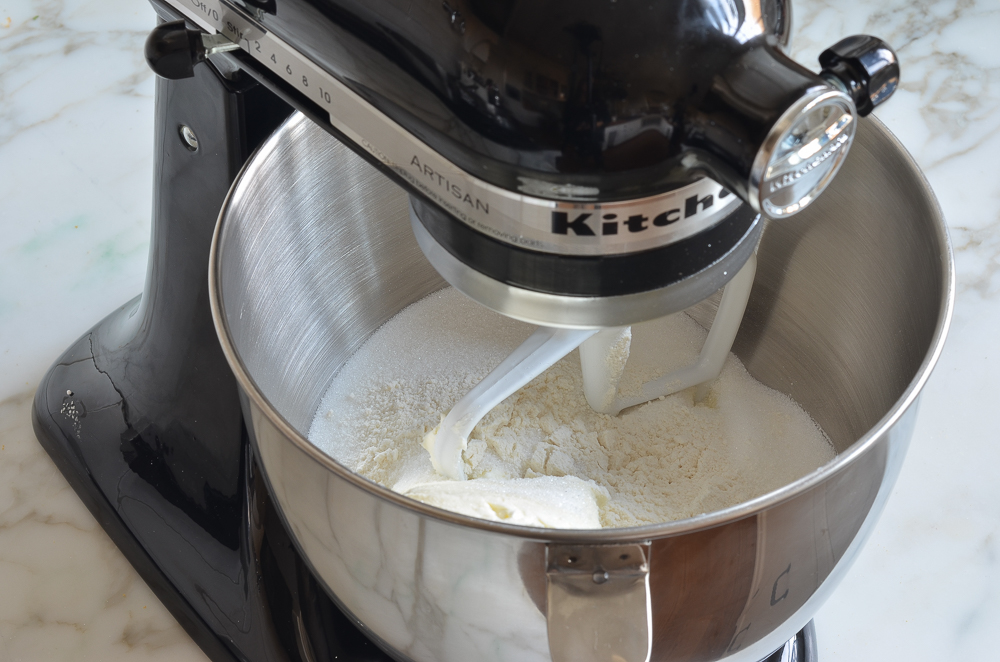
Beat on medium speed until just smooth, about 1 minute. Scrape the bottom and sides of the bowl to be sure the mixture is evenly combined.
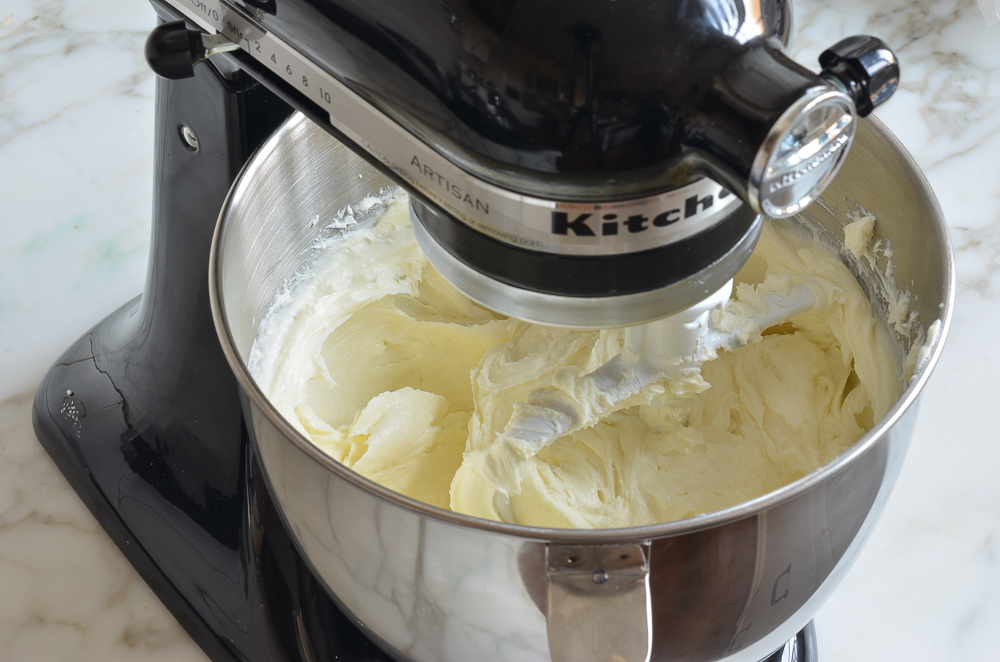
Add the vanilla, lemon zest, lemon juice, and salt; beat on low speed until just combined.
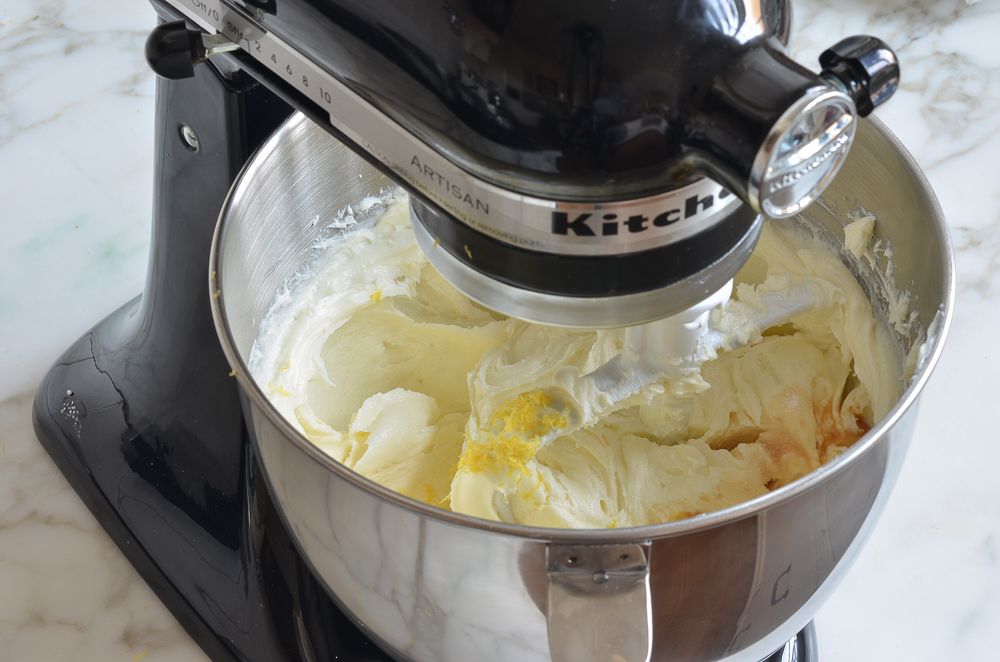
Add the eggs, one at a time, mixing on low speed until incorporated, scraping the bowl as necessary.
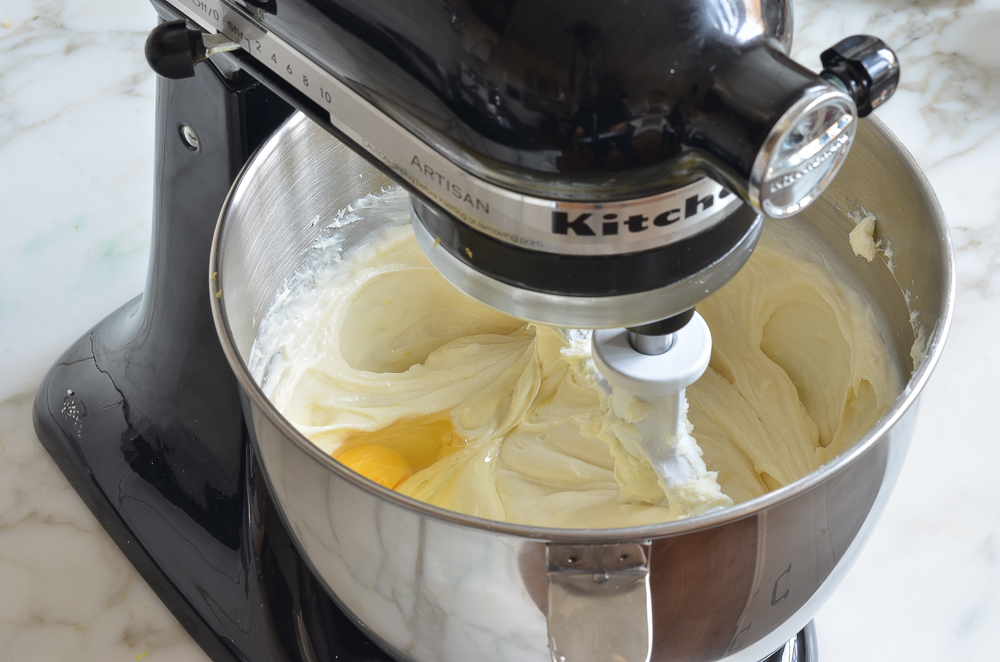
Mix in the sour cream.
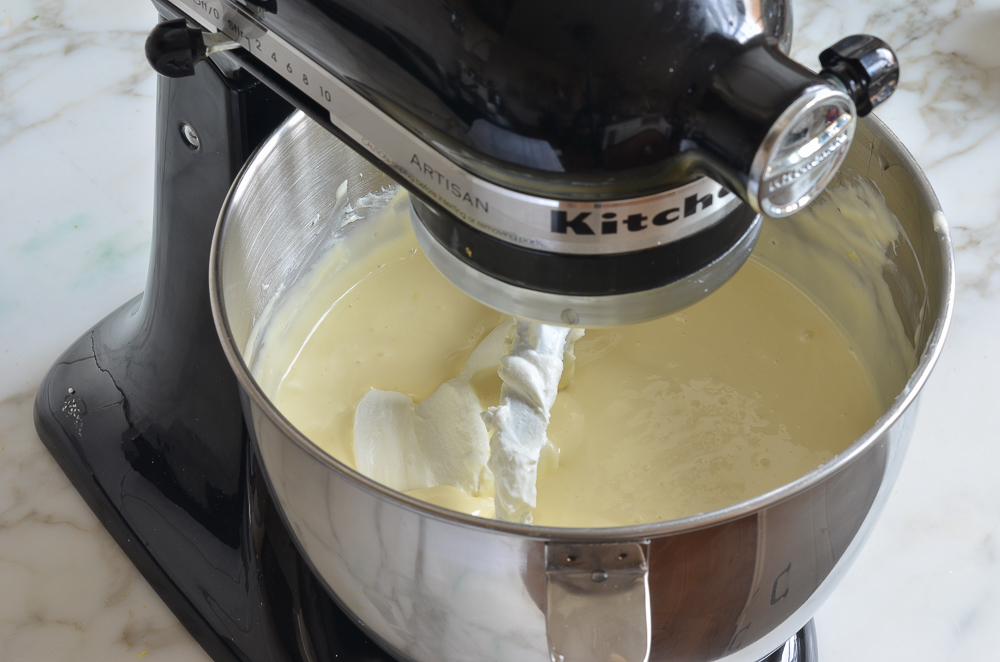
Make sure the batter is uniform but do not over-mix.
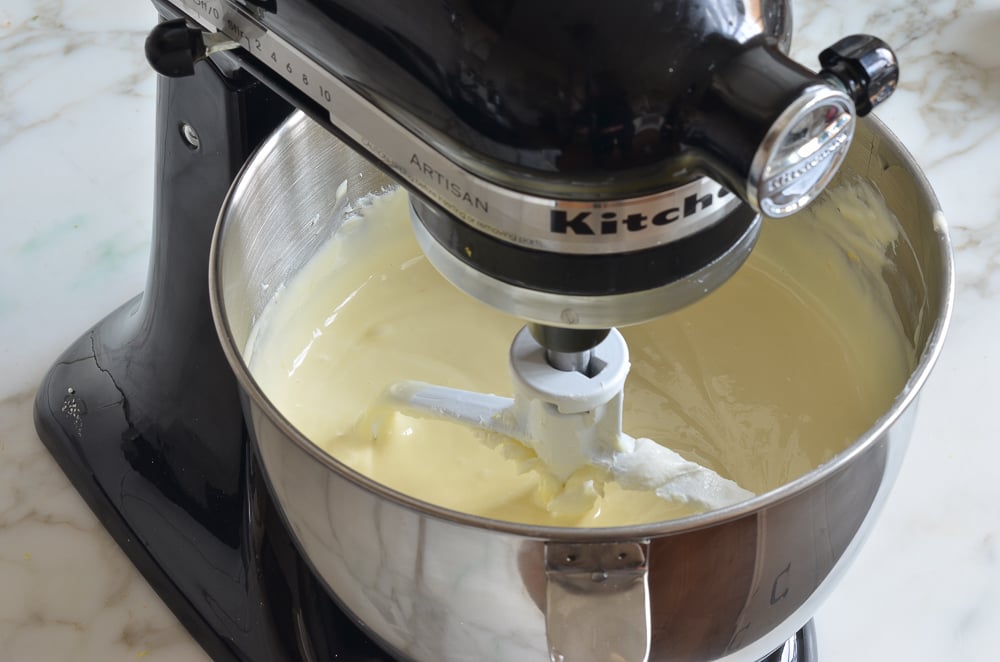
Pour the batter on top of the crust.
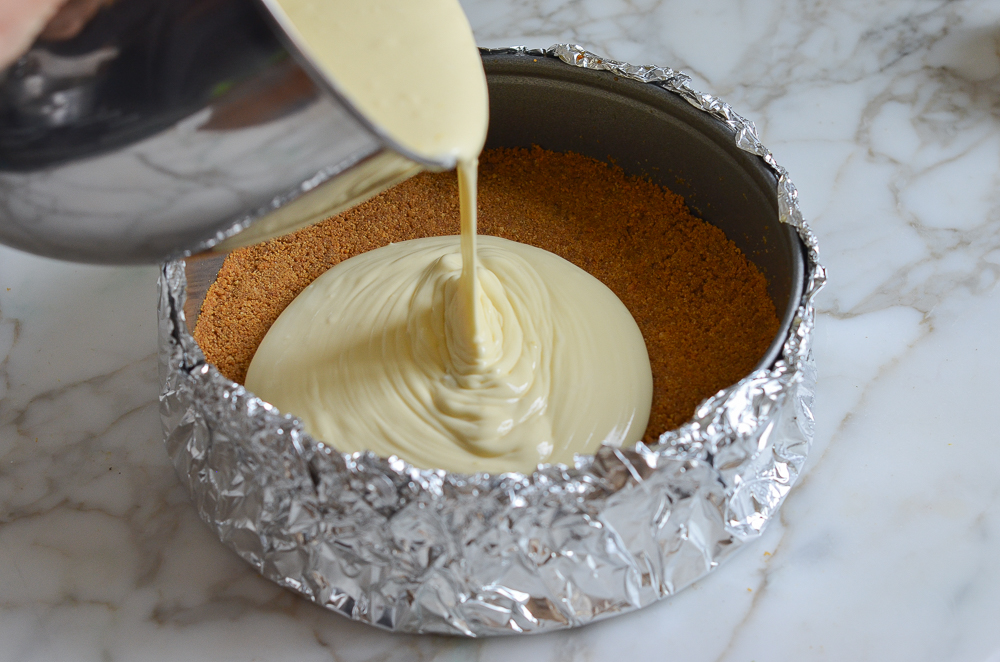
Step 4: Bake
Set the unbaked cheesecake in a large roasting pan. Pour boiling water into the roasting pan until it comes about one inch up the side of the cake pan. The water bath (also called a bain marie) regulates the temperature and keeps the cheesecake baking at an even, low heat. The steam/humidity created by the water bath also protects the cheesecake from drying out and cracking.
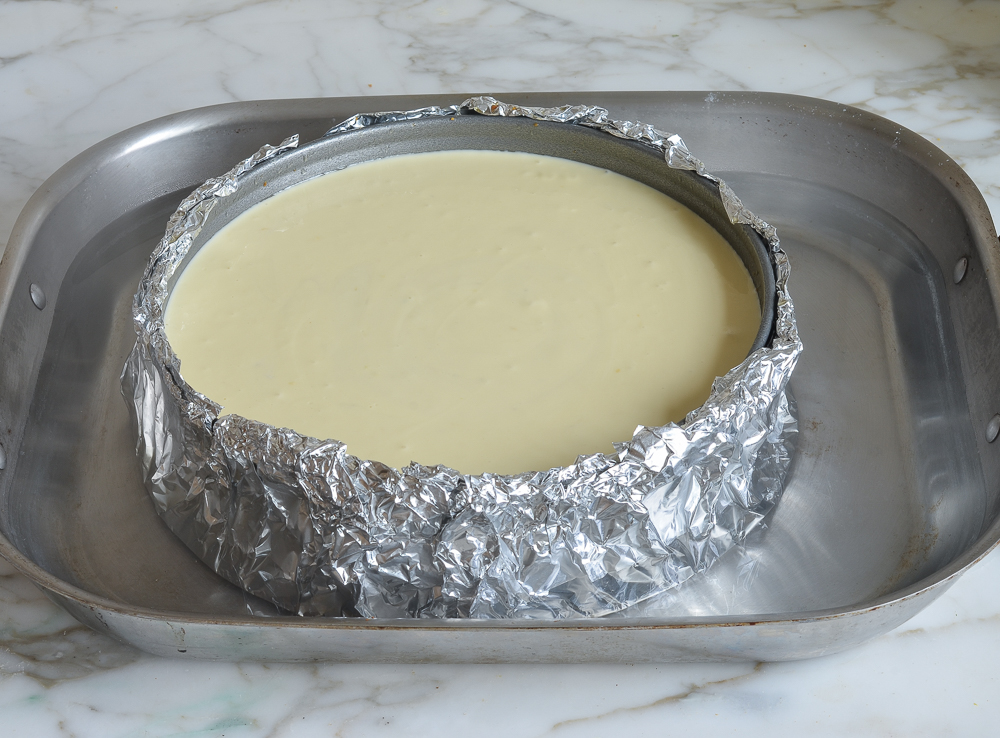
Bake until the cake is just set, 1 hour and 30 minutes to 1 hour and 45 minutes. The cake should not look liquidy at all but will wobble just a bit when the pan is nudged; it will continue to cook as it cools.
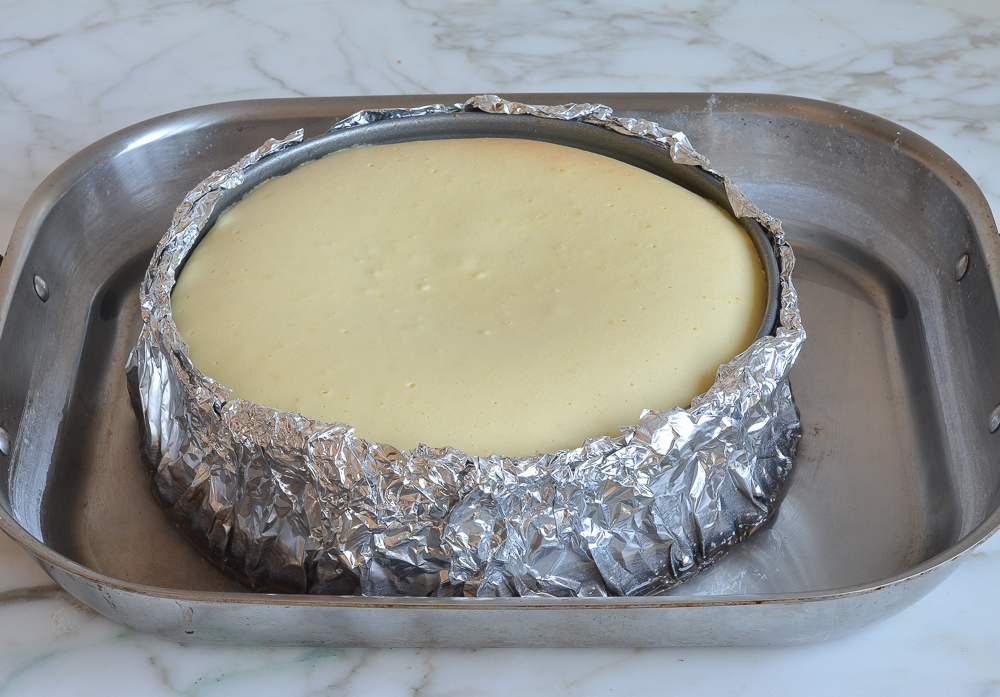
Step 5: Cool
Carefully remove the roasting pan from the oven and set it on a wire rack. Cool the cheesecake in the water bath until the water is just warm, about 45 minutes. Remove the springform pan from the water bath, discard the foil, and transfer the cheesecake to the refrigerator to cool for at least 8 hours or overnight.
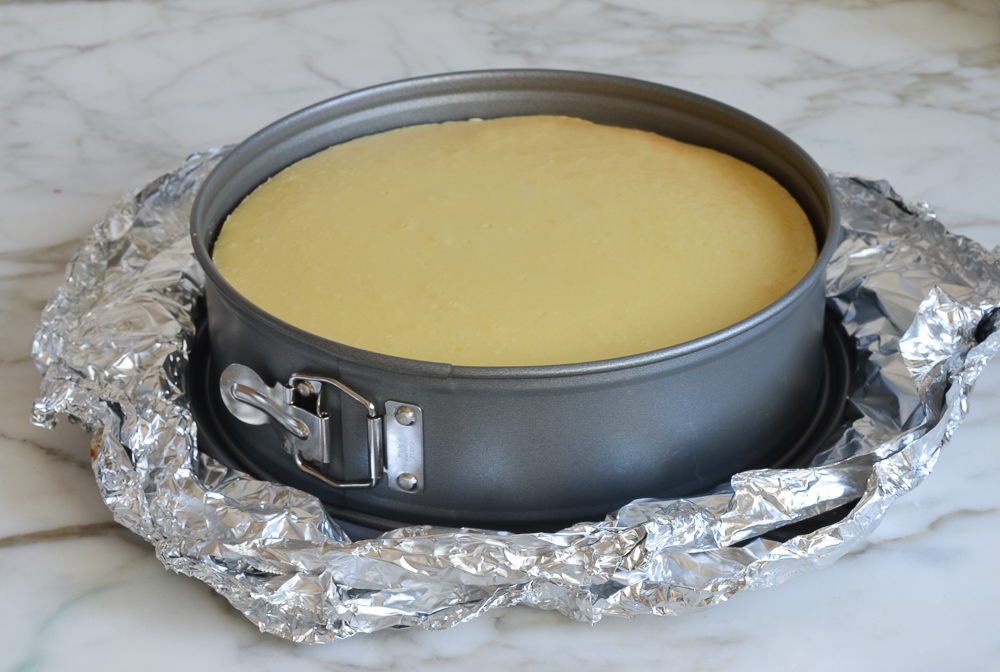
Remove the sides of the springform pan. You can serve the cheesecake right from the base of the springform pan. Or, if you’d like to transfer it to a serving platter, run a long, thin spatula between the crust and the pan bottom, and then use two large spatulas to transfer the cheesecake to a serving dish. Slice with a sharp knife, wiping the knife clean between slices. Serve with berry sauce, if you like.
Video Tutorial

You May Also Like
Classic New York Cheesecake
Think making cheesecake is difficult? Think again! This foolproof recipe delivers a cheesecake that’s dense, rich, and creamy—rivaling those from New York’s most beloved delis—and it’s simple enough for beginners to master.
Ingredients
For the Crust
- 1½ cups graham cracker crumbs, from 12 whole crackers
- 5 tablespoons unsalted butter, melted
- 2 tablespoons sugar
- ⅛ teaspoon salt
For the Filling
- 32 oz (four 8-oz blocks) cream cheese, at room temperature
- 2 cups sugar
- 3 tablespoons all-purpose flour
- 4 teaspoons vanilla extract
- 1 teaspoon packed lemon zest, from 1 lemon
- 2 teaspoons fresh lemon juice, from 1 lemon
- ¼ teaspoon salt
- 6 large eggs
- ½ cup sour cream
- Special equipment: 9- or 10-inch springform pan; 18-inch heavy-duty aluminum foil (see Pro Tip)
- Berry sauce, for serving (optional)
Instructions
For the Crust
- Preheat the oven to 375°F and set an oven rack in the lower middle position. Wrap a 9- or 10-inch springform pan with one large piece of heavy-duty aluminum foil, covering the underside and extending all the way to the top so there are no seams on the bottom or sides of the pan. Repeat with another sheet of foil for insurance. Spray the inside of the pan with nonstick cooking spray.
- Make the crust: In a medium bowl, combine the graham cracker crumbs, melted butter, sugar, and salt. Stir until well combined. Press the crumbs into an even layer on the the bottom of the prepared pan. Bake the crust for 10 minutes, until set. Remove the pan from the oven and set aside.
- Reduce the oven temperature to 325°F. Set a kettle of water to boil.
- Make the batter: In the bowl of an electric mixer fitted with the paddle attachment or beaters, beat the cream cheese, sugar, and flour together on medium speed until just smooth, about 1 minute. Scrape the bottom and sides of the bowl to be sure the mixture is evenly combined. Add the vanilla, lemon zest, lemon juice, and salt; beat on low speed until just combined. Add the eggs, one at a time, mixing on low speed until incorporated, scraping the bowl as necessary. Mix in the sour cream. Make sure the batter is uniform but do not over-mix.
- Check to make sure your oven has cooled to 325°F, then set the cheesecake pan in a large roasting pan. Pour the batter on top of the crust. Pour the boiling water into the large roasting pan to come about 1 inch up the side of the cake pan. Bake until the cake is just set, 1 hour and 30 minutes to 1 hour and 45 minutes. (If the cheesecake starts to look too golden on top towards the end, cover it loosely with foil.) The cake should not look liquidy at all but will wobble just a bit when the pan is nudged; it will continue to cook as it cools. Carefully remove the roasting pan from the oven and set it on a wire rack. Cool the cheesecake in the water bath until the water is just warm, about 45 minutes. Remove the springform pan from the water bath and discard the foil. If necessary, run a thin-bladed knife around the edge of the cake to make sure it's not sticking to the sides (which can cause cracks as it cools), then cover with plastic wrap and transfer to the refrigerator to cool for at least 8 hours or overnight.
- For serving: Remove the sides of the springform pan. Serve the cheesecake right from the base of the pan; or, to transfer it to a serving platter, run a long, thin spatula between the crust and the pan bottom, and then use two large spatulas to carefully transfer the cheesecake to a serving dish. Slice with a sharp knife, wiping the knife clean between slices. Serve with berry sauce, if you like.
- Make Ahead: The cheesecake can be made and stored in the springform pan in the fridge, tightly covered with plastic wrap, up to two days ahead of time.
- Freezer-Friendly Instructions: The cheesecake can be frozen for up to 3 months. To freeze, place the cake in the freezer briefly, unwrapped, to firm it up. Then double-wrap it tightly with aluminum foil or plastic freezer wrap, or place it in heavy-duty freezer bag. Thaw in the refrigerator the night before you plan to eat it.
- Pro Tip: Springform pans are notorious for leaking. Since a cheesecake bakes in a water bath, the foil prevents the water from seeping in during baking. Please do not attempt to use standard 12-inch (30cm) aluminum foil – you can’t have any foil seams on the bottom or sides of the pan. No matter how well (or how many times) you wrap the pan, if there are seams exposed to the water, the water will find a way in. Even when wrapped properly, you can occasionally get some condensation inside the foil. If this happens, don’t worry – the crust is likely just a bit moist around the edges. Simply remove the sides of the springform pan before refrigerating and let it dry out in the refrigerator.
Nutrition Information
Powered by ![]()
- Per serving (10 servings)
- Serving size: 1 slice
- Calories: 659
- Fat: 43 g
- Saturated fat: 24 g
- Carbohydrates: 59 g
- Sugar: 49 g
- Fiber: 1 g
- Protein: 11 g
- Sodium: 464 mg
- Cholesterol: 233 mg
This website is written and produced for informational purposes only. I am not a certified nutritionist and the nutritional data on this site has not been evaluated or approved by a nutritionist or the Food and Drug Administration. Nutritional information is offered as a courtesy and should not be construed as a guarantee. The data is calculated through an online nutritional calculator, Edamam.com. Although I do my best to provide accurate nutritional information, these figures should be considered estimates only. Varying factors such as product types or brands purchased, natural fluctuations in fresh produce, and the way ingredients are processed change the effective nutritional information in any given recipe. Furthermore, different online calculators provide different results depending on their own nutrition fact sources and algorithms. To obtain the most accurate nutritional information in a given recipe, you should calculate the nutritional information with the actual ingredients used in your recipe, using your preferred nutrition calculator.

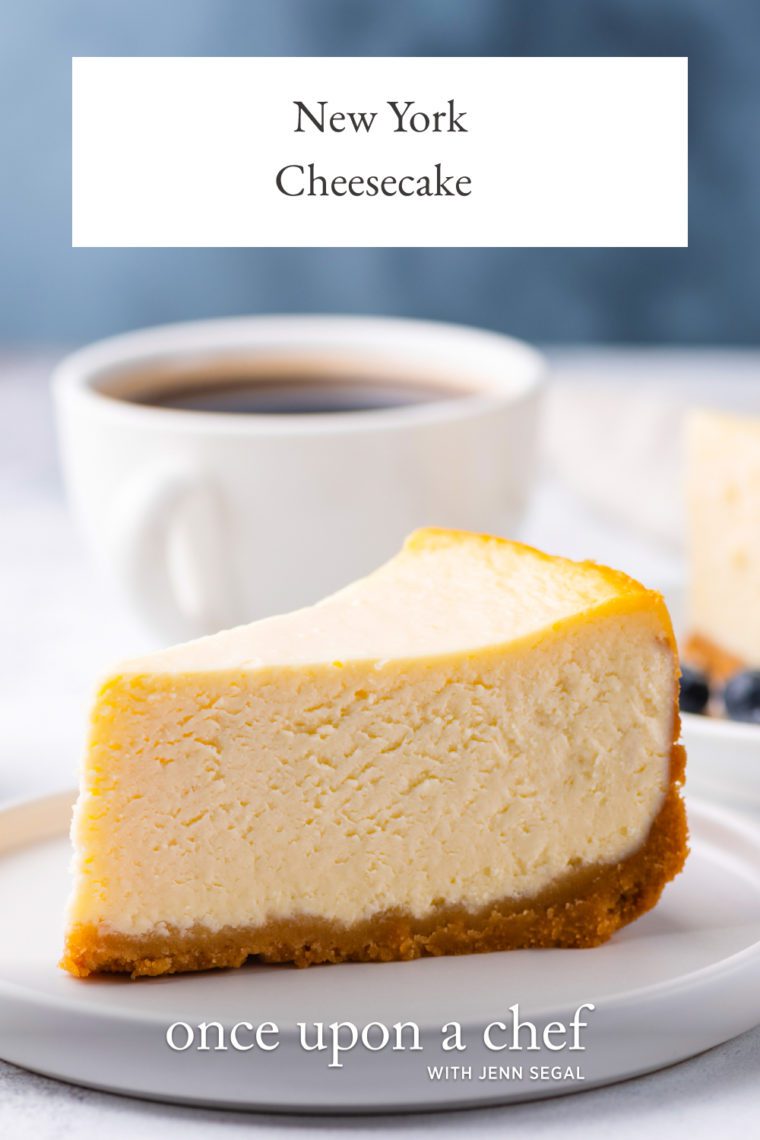
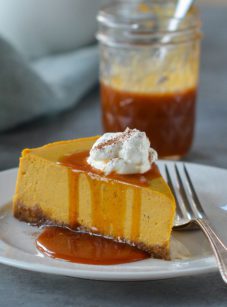

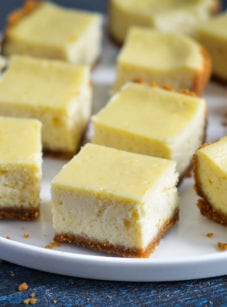
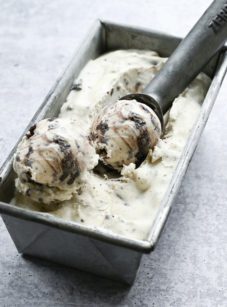
My daughter and I made this yesterday for upcoming 🍁Thanksgiving dinner and couldn’t resist a slice! I topped it with the berry sauce and it was so delicious! I was disheartened because I had some leakage but it didn’t affect the flavor or texture! I did leave out the sugar from the crust and reduced the sugar in the filing to 1 1/4 cups. The added lemon is divine…🍋✨ my cake looked just the photo!
Jenn, your recipes are so reliable and make me feel like I can cook! For that, I am so grateful!
💗
Hope you had a great Thanksgiving!
How would you make this Oreo? Can you add any cookies to the batter? If i did an Oreo crust would I mix it with graham crackers as well?
Hi Karen, If you’d like to use an oreo crust for this, no need to mix in graham cracker crumbs as well. And cheesecake can be pretty finicky. I haven’t tried mixing anything like cookies into the batter, so it’s hard to say for sure how it will impact the recipe. You could sprinkle chopped Oreos on top to be safe. If you do try it with the cookies mixed in, I’d love to hear how it turns out!
So pleased with this recipe, made for a friend’s birthday. He loved it and so did I. I halved the recipe and used a 6″ springform pan. It had a lot of probing with my Thermapen and took it out the first time at 150 degrees. It seemed way too liquidy so returned to oven and ultimately took out at 162. There were also oven issues of my own doing. Bottom line, it tasted fabulous, great texture and it got rave reviews from my guests. I definitely learned a lot and have added my notes to the recipe. The crack in the middle was the perfect place for the birthday candles.
I didn’t have sour cream, so I’m using 1.2 dl double cream instead. How will that affect cooking time? A bit confusing to have cooking time 1:55 on top and 1:30-1:45 in the text, but 1:45 for the cake + 10 min for the bottom is what makes the 1:55, right?
Hi Jan, Although I don’t have experience with double cream, I don’t think that using it will impact baking time. And I’m sorry you found the way the timing is written to be confusing. Yes, you’re correct – the 1:55 is the combined timing for the crust and the filling. Hope that helps and that you enjoy!
On Thursday I will be making this cheesecake as a birthday cake for someone special and am very excited to try your recipe because of the many outstanding reviews posted. I’ve also been peeking at many other recipes on your website and will be coming back to explore further.
In the meantime, I have a question regarding eggs. I have been baking for many years and large eggs used to weigh 55 grams each, now the so called large eggs weigh much less than that. I’d like to know how many grams your large whole eggs weigh out of the shell so I can duplicate that amount when making the cheesecake. Sure would appreciate your feedback. Thank you.
Hi Linda, I just weighed a large egg out of the shell and it was 50 grams. Hope that helps!
Hi Jenn: Thank you so much for your speedy reply. I sincerely appreciate it. I am making the cheesecake tomorrow and feel more confident now due to your feedback and will move forward with more confidence with the knowledge you provided. I’m excited to try this recipe for a friend that has been a NY cheesecake fan for many years. I will let you know how it comes out.
I have made several cheese cakes used numerous recipes. this by far had the best results. This is a 5 star restaurant quality cheese cake and so much cheaper than eating there.
How can I determine how long a thicker cheese cakes needs to cook for? I want to make one that I’d about 7″ – 8″ thick. Also, any suggestions to where I could buy different size cheese cake pans? I’ve only been able to find the standard size.
Hi Ken, I actually wouldn’t recommend making a much thicker cheesecake as I don’t think it will bake evenly (and I haven’t seen deeper cheesecake pans — maybe because it’s unlikely that it would be baked that way). Hope that helps!
Amazon has a 3 pack of springform pans, different sizes. So does my grocery store.
I tried this recipe and it turned out horrible. I followed the recipe down to a T and it turned into Basque Burnt Cheesecake and looks nothing like the picture listed. Upon further research, I found the recipe is that of a basque and that needs to be noted so people like myself aren’t attempting their first cheesecake and ruining someone’s birthday because of it.
Do you have to do the warm bath for the baking? I can’t find a roasting pan big enough! Thanks!
Hi Alyson, you really do need the water bath for this. If you’d like a recipe that doesn’t require one, these cheesecake bars are delicious — hope that helps!
Can I scale this recipe down to using a smaller 6inch pan? Thanks!
Yes, Steve, I think you could get away with using a 6-inch springform pan if you halve this. It won’t need to bake as long; I’d start checking it at 45 minutes. Hope that helps! 🙂
This recipe was perfect. Never made this kind of cheesecake and it turned out amazing. Everyone loved it! This recipe is probably the best recipe I could ever use/find. If you want to make a good cheesecake, use this recipe for sure. So happy with the results 🙂